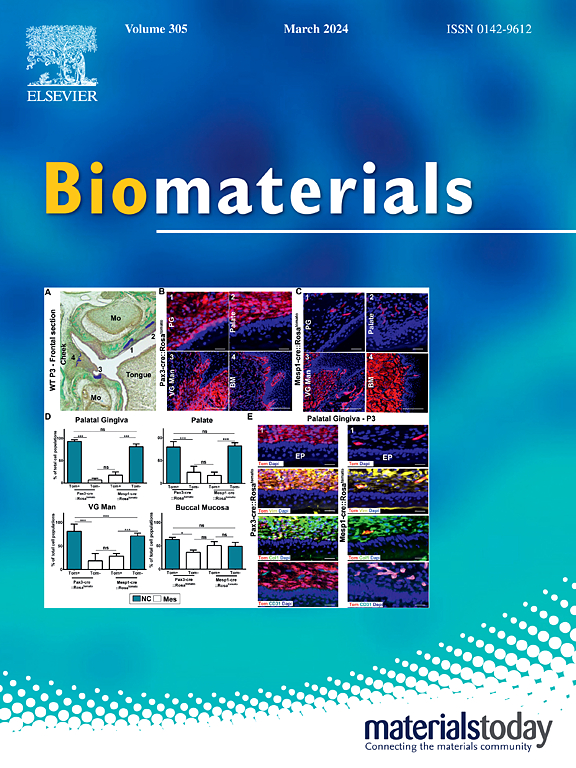Self-sustained biomimetic bioelectronic accelerated metabolic reprogramming of bone regeneration
IF 12.8
1区 医学
Q1 ENGINEERING, BIOMEDICAL
引用次数: 0
Abstract
Bionic bioelectronics has promising applications in bone defect repair, with current research primarily focusing on the development of electroactive biomaterials and self-powered systems, which can mimic the electrophysiological microenvironment of natural bone tissue, accelerating bone healing by promoting osteoblast proliferation and differentiation through electrical stimulation. However, the biological mechanisms of bionic electrical stimulation in bone defect repair remain incompletely understood. Here, the study developed a self-sustained biomimetic bioelectronic system comprising a triboelectric/piezoelectric hybrid nanogenerator (TP-hNG) and a multifunctional gold-coated polymer internal fixation plate (GP-IFP), which utilizes the natural biomechanical properties of rat heartbeat and respiratory movements to generate bionic electric signals (Bio-SIG) that are closely related to physiological neurofeedback signals. The Bio-SIG can disrupt the glucose metabolic homeostasis in osteoblasts, enhancing the osteoblasts’ dependence on aerobic glycolysis while attenuating dependence on oxidative phosphorylation (OXPHOS). This metabolic shift triggers critical steps in osteogenic differentiation, bone formation and mineralization, effectively facilitating the repair of bone defects. This work reveals the key role of glucose metabolic reprogramming in osteogenesis mediated by bionic electrical stimulation, elucidates the complex regulatory mechanisms of bionics in bone regenerative medicine and deepens the understanding of how biofeedback electrical stimulation precisely regulates the bone regeneration process, which provides a solid theoretical basis for clinical personalized treatment.
自我维持的仿生生物电子加速骨再生的代谢重编程
仿生生物电子学在骨缺损修复中有很好的应用前景,目前的研究主要集中在电活性生物材料和自供电系统的开发上,这些材料可以模拟天然骨组织的电生理微环境,通过电刺激促进成骨细胞的增殖和分化来加速骨愈合。然而,仿生电刺激在骨缺损修复中的生物学机制尚不完全清楚。本研究开发了一种由摩擦电/压电混合纳米发电机(TP-hNG)和多功能镀金聚合物内固定板(GP-IFP)组成的自维持仿生生物电子系统,该系统利用大鼠心跳和呼吸运动的自然生物力学特性产生与生理神经反馈信号密切相关的仿生电信号(Bio-SIG)。Bio-SIG可破坏成骨细胞葡萄糖代谢稳态,增强成骨细胞对有氧糖酵解的依赖性,减弱对氧化磷酸化(OXPHOS)的依赖性。这种代谢转变触发了成骨分化、骨形成和矿化的关键步骤,有效地促进了骨缺损的修复。本研究揭示了葡萄糖代谢重编程在仿生电刺激介导成骨过程中的关键作用,阐明了仿生学在骨再生医学中的复杂调控机制,加深了对生物反馈电刺激如何精确调控骨再生过程的认识,为临床个性化治疗提供了坚实的理论基础。
本文章由计算机程序翻译,如有差异,请以英文原文为准。
求助全文
约1分钟内获得全文
求助全文
来源期刊

Biomaterials
工程技术-材料科学:生物材料
CiteScore
26.00
自引率
2.90%
发文量
565
审稿时长
46 days
期刊介绍:
Biomaterials is an international journal covering the science and clinical application of biomaterials. A biomaterial is now defined as a substance that has been engineered to take a form which, alone or as part of a complex system, is used to direct, by control of interactions with components of living systems, the course of any therapeutic or diagnostic procedure. It is the aim of the journal to provide a peer-reviewed forum for the publication of original papers and authoritative review and opinion papers dealing with the most important issues facing the use of biomaterials in clinical practice. The scope of the journal covers the wide range of physical, biological and chemical sciences that underpin the design of biomaterials and the clinical disciplines in which they are used. These sciences include polymer synthesis and characterization, drug and gene vector design, the biology of the host response, immunology and toxicology and self assembly at the nanoscale. Clinical applications include the therapies of medical technology and regenerative medicine in all clinical disciplines, and diagnostic systems that reply on innovative contrast and sensing agents. The journal is relevant to areas such as cancer diagnosis and therapy, implantable devices, drug delivery systems, gene vectors, bionanotechnology and tissue engineering.
 求助内容:
求助内容: 应助结果提醒方式:
应助结果提醒方式:


